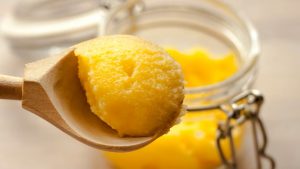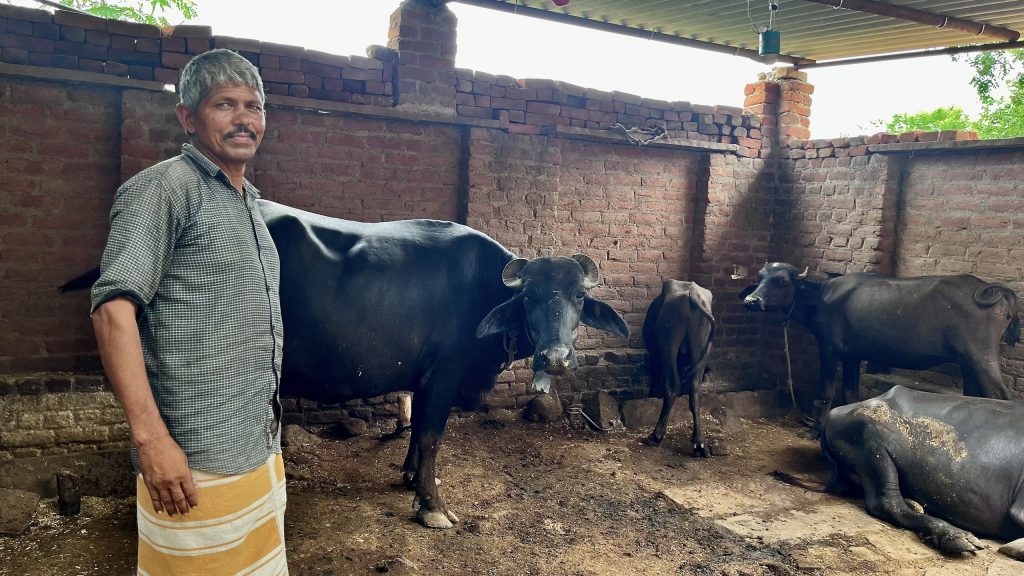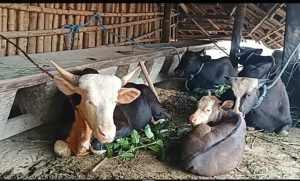
The impacts of climate change, particularly high heat, are impacting milk production and the revenue of the small farmers dependent on it.
On a humid, late-July day this year, Chandan Singh went to milk his buffaloes, only to find five of them spewing foamy saliva. The village veterinarian diagnosed haemorrhagic septicaemia (HS), a bacterial disease also known as gala ghotu rog. Treatment cost around INR 15,000 (USD 179), which roughly equates to six weeks of the dairy farmer’s income. Despite this intervention, two of his buffaloes died within days.
“They developed swelling in the throat and the eyes became red. They couldn’t breathe,” Singh says.
Singh, who lives in Punawali Kalan village in the north of India, is not alone in suffering such losses. Around 75 cattle have died within a five-kilometre radius of his village this monsoon. HS thrives in moist and humid conditions. This makes it a recurring challenge for farmers, particularly as climate change increases temperatures and intense rainfall events in the region.

This year, Punawali Kalan’s dairy farmers have also experienced plummeting milk yields due to extreme heat waves. Rajkumar Rajput, another local farmer, saw his daily production drop from 45 to 30 litres as winter became summer. Rajput supplies the daily milk demands of 40 households and says he “had to buy milk to cover the shortfall”.
In 2017, India’s Central Institute for Research on Buffaloes conducted a study on climate change and buffalo farming. It said sudden extreme temperature variations can cause a 10-30% drop in milk production during the first lactation, and a 5-20% drop during the second and third lactations. These impacts continue for 2-5 days.
This challenge is only set to grow. A 2022 study by the Indian Grassland and Fodder Research Institute estimates that, as temperatures rise, the growing drop in annual milk production in the northern plains – which account for 30% of India’s milk production – could amount to 361,000 tonnes by 2039. Such a drop would represent losses amounting to INR 11.93 billion (USD 142 million).
A 2022 Lancet study warned that, if global greenhouse gas emissions remain high, rising temperatures could cut milk production in arid regions by 25% by 2085.
The direct and indirect threats of climate change
Abhinav Gaurav, a livestock management advisor for the climate action NGO Environmental Defense Fund, says climate change is impacting cattle both directly and indirectly. The animals themselves struggle with intensifying heat and humidity, and the climate impacts also interfere with the production of their fodder, alter their pastures, and increase their exposure to disease.
A 2016 study led by Bengaluru’s National Institute of Animal Nutrition and Physiology suggested most milk production losses were incurred via these indirect climate change impacts. Predominantly, that means shrinking – or simply unavailable – feed and water sources.
Climate change affects forage quality and availability by shifting precipitation patterns, raising temperatures, and altering vegetation. This compounds water scarcity, which is especially harmful to buffaloes because their thick black skin makes them particularly vulnerable to heat stress. “The loss of traditional wallowing ponds exacerbates this vulnerability,” adds Gaurav.

Yunus, another dairy farmer in northern India, has seen fodder prices surge when crops fail in heavy rainfall. “I had to buy fodder at INR 1,700 per quintal, compared to the usual INR 700-800,” he says. This summer, milk output from Yunus’ 30 buffaloes dropped from 200 to 150 litres.
In the dairy sector, milk prices depend on fat and solid-not-fat content. This content decreases in the lean period (April to September) as heat and humidity rise. Climate change exacerbates this by making heat stress and erratic rainfall more likely, meaning less income for milk producers.

| Buffalo milk | October-March | April-September (lean period) |
| SNF (solid-not-fat) content | 9.2% | 8.8% |
| Fat content | 6.6% | 6.0% |
| Cow milk | ||
| SNF content | 8.6% | 8.0% |
| Fat content | 4.5% | 4.0% |
An industry blinkered by target-chasing
Launched a decade ago, the Indian government’s National Livestock Mission aims to boost productivity and fodder production in the sector, but it fails to consider the impact of climate change.
Dialogue Earth consulted Namrata Ginoya, senior manager of the Resilience and Energy programme at the World Resources Institute India. She has studied adaptations to climate change in dairy farming, and says farmers are beginning to understand how climate variability and its impacts on rainfall, heat and moisture will affect their cropping systems. On the other hand, she notes there is still insufficient information available to farmers on how rising heat stress could affect their cattle.
In response to a Right-to-Information request filed by Dialogue Earth, the Uttar Pradesh Dairy Development Board revealed that between April 2008 and March 2024, a total of 840,063 dairy animals were insured under this insurance scheme. Between April and August 2024, another 53,962 were added. During the financial year 2017-18, the highest rates of insurance occurred, when 204,296 animals became covered. During 2009-10, only 7,808 became covered.
During 2018-19, there were 19 and 33 million cattle and buffalo respectively in Uttar Pradesh, according to the government’s livestock census of 2019.
Therefore, during the past 15 years, the percentage of dairy animals insured in Uttar Pradesh has never been higher than 0.4%.
Some private firms, like DeHaat in Bihar and the Kerala Co-operative Milk Marketing Federation (known as Milma in Kerala and Kutch Milk Union in Gujarat), are piloting heat-based cattle insurance. DeHaat’s head of dairy input, Digvijay Singh, says the company registered 4,500 farmers when it rolled out its scheme this March, covering them from April to July. DeHaat ultimately paid out approximately 55 claims for that period. The company aims to expand the scheme in 2025 to cover longer time periods.
You can now read the most important #news on #eDairyNews #Whatsapp channels!!!
🇮🇳 eDairy News ÍNDIA: https://whatsapp.com/channel/0029VaPidCcGpLHImBQk6x1F

















